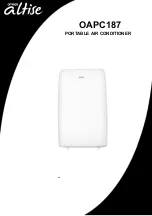
22
ENGLISH
INSTALLATION
Operate the unit for 15~20 minutes, then
check the system refrigerant charge:
- Measure the pressure of the gas side service
valve.
- Measure the air temperature from inlet and
outlet of air conditiioner.
- Ensure the difference between the inlet and
outlet temperature is more than 8°C.
- For reference; the gas side pressure at opti-
mum condition is shown on table (cooling)
The air conditioner is now ready to use.
*The feature can be changed according a type of
model.
This is performed when the unit is relocated
or the refrigerant circuit is serviced.
Pump Down means collecting all refrigerant
into the outdoor unit without the loss of refrig-
erant.
- Connect a low-pressure gauge manifold hose
to the charge port on the gas side service
valve.
- Open the gas side service valve halfway and
purge the air in the manifold hose using the
refrigerant.
- Close the liquid side service valve(all the
way).
- Turn on the unit's operating switch and start
the cooling operation.
- When the low-pressure gauge reading be-
comes 1 to 0.5kg/cm
2
G(14.2 to 7.1 P.S.I.G.),
fully close the gas side valve and then
quickly turn off the unit. Now Pump Down
procedure is completed, and all refrigerant is
collected into the outdoor unit.
Discharge
temperature
Discharge air
Inlet temperature
Refrigerant
Outside ambi-
ent TEMP.
The pressure of
the gas side
R-410A
35°C
8.5~9.5kg/cm
2
G(1
20~135 P.S.I.G.)
NOTE
!
If the actual pressure is higher than
shown, the system is most likely over-
charged, and charge should be removed.
If the actual pressure are lower than
shown, the system is most likely under-
charged, and charge should be added.
CAUTION
Be sure to perform Pump Down proce-
dure in the cooling mode.
!
Pump Down Procedure
Pump down
Evaluation of the performance




































